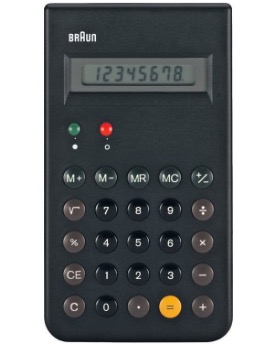
The aesthetic I chose is dubbed the “Braun Style,” which was created by Dieter Rams in the 1960s and inspired designers like Jonathan Ive at Apple. Dieter Rams is a German industrial designer best known for his work with the electronics company Braun during the 1950s and 60s. His designs for Braun, which included products such as radios, turntables, and calculators, have become iconic examples of minimalist and functional design. The “Braun style,” as it is often called, is characterized by its simplicity, clarity, and focus on the user. Rams believed good design should be unobtrusive and serve a clear purpose, and his work with Braun reflects this philosophy. As seen below (in figure 2), with the ET 66 calculator design, each button color and convex shape is chosen to ensure intuitive use while retaining the simplistic aesthetic.


Rams chose the equal and on/off buttons to be yellow, green, and red, respectfully, to make it easier for the user to identify. In contrast, the other buttons were chosen with a darker shade with black numbers, brown math functions, and dark green memory functions. As seen in figure 3, on the right, the iPhone calculator app was inspired by Rams iconic ET 66 design.
One of the key principles of the Braun style is the concept of “less but better.” This means that rather than adding more features or ornamentation to a product, the focus should be on simplifying and streamlining it to make it as efficient and user-friendly as possible. This key principle can be seen in his 1961 Braun Tischsuper RT 20 radio and 1956 Braun SK Phonosuper record player below.


These designs encapsulate the Rams ideology of “less but better” as each design lacks fancy or showy features that take away at the intuitive nature of the design and usefulness of the product. With the single rectangular frequency range, the circular monotone pastel buttons, and straight cut grills there are no design features that don’t add functionality.
In addition to his work with Braun, Rams also developed a set of ten principles for good design, which include concepts such as innovation, responsibility, and sustainability. These principles are still widely referenced and admired as a benchmark for good design and are used in design education and professional practice. Rams second principle, “good design makes a product useful,” can be seen in figure 6 with his design of the Braun TP 1, the Portable Transistor Radio and Phonograph.


Rams design of the portable radio and phonograph is sleek, innovative, unobtrusive, and useful for only taking up a 9 x 6 inch volume. Overall, Dieter Rams and the Braun style represent the epitome of functional, minimal, and user-centered design. His work and design principles are still highly relevant today and continue to inspire designers and design enthusiasts worldwide.
References:
Elengical, Jerry. “Dieter Rams: Celebrating the Genius with 10 Products for 10 Commandments of Design.” STIRworld, STIRworld.com, 20 May 2021, https://www.stirworld.com/inspire-people-dieter-rams-celebrating-the-genius-with-10-products-for-10-commandments-of-design.
vignelli, massimo. “1.” Брендинговое Агентство Rolling.design в Москве, 3 Sept. 2021, https://rolling.design/en/blog/dieter-rams#:~:text=Rams%20managed%20to%20create%20a,%2Dwhite%2Dgray%20color%20scheme. .

4 Comments. Leave new
This was super fascinating. It is interesting the viewpoint that a product cannot be useful unless the design is good. It makes it so clear why good design is just as necessary as the engineering. Are these ten principles of design the foundation for the minimalistic design that has taken over in the recent years?
Hi Hannah,
As I look into minimalist designs over the last few years, I see little pieces of design that seem to take inspiration and direction from the ten principles Rams defined. I would say that the more prominent principles that were passed on are:
“A good design is aesthetic, unobtrusive, and honest.” From these principles, I do currently see clean organic shapes and natural pallets and textures in the recent minimalist design. Thank you for your comment and question!
– Hayden
Rams and his ten principles of design are some of my greatest influences as a product designer. His designs are simple intuitive and modular, and often mirror technological advancements. His Vistoe 606 shelving unit was developed around the same time as some of the first organizational operating systems, and the two share many attributes. What do you think of his connection to Apple with the calculator and the iPods similarity to his portable radio? Is it theft or inspiration and is it ethical creation?
Hi George,
When I think of recent designers taking inspiration from past designs like the Apple calculator and the iPod, I think of the quote, “Imitation is the highest form of flattery.” In this context, I feel as if it is an inspiration since the current designs follow some of the design principles that Rams defined as they are innovative, useful, and unobtrusive. Thank you for your comment and question!
-Hayden